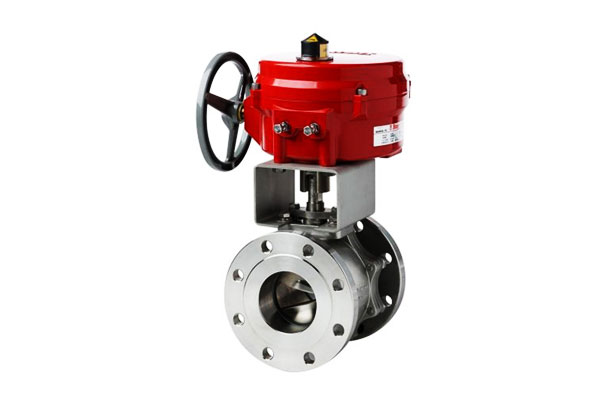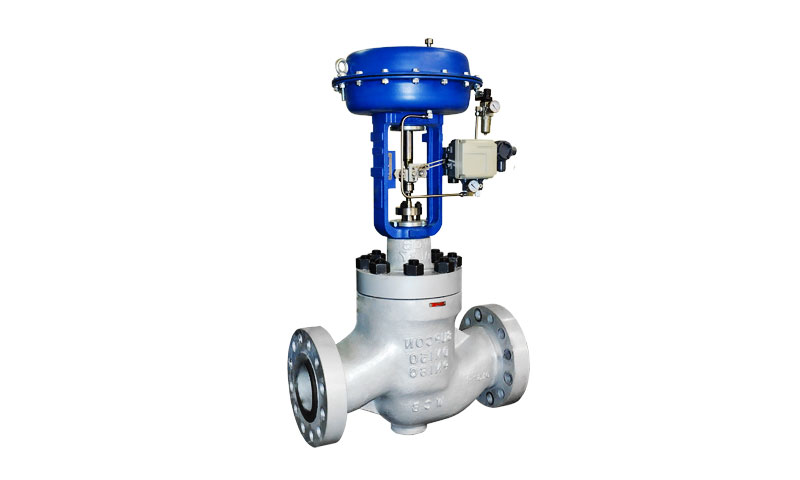1. 介绍
控制阀是大多数自动化过程系统中的主要最终控制元件: 它接收来自控制器的命令并调节流道以调节流量等过程变量, 压力, 温度和液位.
正确选择, 浆纱, 控制阀的驱动和集成决定了回路稳定性, 产品质量, 能源消耗与安全;
反过来, 规格不明确或维护不善的阀门是振动的常见根本原因, 吞吐量损失和计划外停机.
2. 什么是控制阀
一个 控制阀 是调节流体流速的机械装置, 压力, 等级, 通过响应控制信号改变流道来控制过程系统内的温度或温度.
它充当 最终控制元件 在自动控制循环中——执行控制器做出的决策,以将过程变量维持在所需的设定点.
与开/关隔离阀不同, 控制阀工作在 连续调制模式, 允许精确调节流量以实现稳定的过程控制.
它们通常由 气动, 电的, 或液压执行器, 翻译信号 (例如。, 4–20 mA 或 3–15 psi) 进入阀门运动.

关键功能
- 动态流量调节 — 提供精确的, 比例控制而不是简单的开/关操作.
- 自动驱动 — 使用气动, 电的, 或液压执行器用于快速且可重复的定位.
- 智能控制集成 — 配备数字定位器 (哈特, 基金会现场总线, 现场总线) 用于诊断, 反馈, 和预测性维护.
- 过程兼容性 — 设计用于处理气体, 液体, 蒸汽, 或宽压力下的浆料 (真空至 700 酒吧) 和温度 (−200°C 至 600 °C) 范围.
- 安全可靠 — 通常配置有故障安全位置 (故障开放, 故障关闭, 原地失败) 确保断电或信号丢失期间系统的完整性.
3. 核心组件及其工作原理
控制阀不仅仅是一个简单的限流器; 是一个 机械系统 由几个相互依赖的组件组成, 每项设计都旨在确保精确调制, 可靠性, 以及在各种工业条件下的耐用性.
阀体
阀体是容纳流道和内部阀件的承压壳体. 它旨在承受系统压力, 温度, 和流体特性.
常见的机身材料包括 碳钢, 不锈钢, 双工, 镍合金, 和特殊耐腐蚀合金.
功能:
- 提供流体流动的主要通道.
- 支持内部装饰 (插头, 座位, 笼) 和执行器安装.
- 通过法兰连接管道, 螺纹, 或焊接连接.
阀门内件
阀内件是指直接控制流量的内部元件, 包括 插头, 座位, 笼, 干, 有时还有孔口.
阀内件设计决定了阀门的 固有流量特性, 压降能力, 以及抗气蚀和侵蚀能力.
要点:
- 插头 & 座位: 主要节流元件. 它们的几何形状定义了线性, 等百分比, 或快开特性.
- 笼式或多级装饰: 用于高压降应用以降低噪音, 防止气蚀, 并提高稳定性.
- 材料选择: 硬幕 (例如。, 星际, 碳化钨) 增强耐磨性; 柔软的座椅 (ptfe, 弹性体) 提供紧密关闭,但有温度/压力限制.
执行器
执行器将控制信号转换为机械运动, 要么是线性的 (用于截止阀或隔膜阀) 或旋转式 (用于球阀或蝶阀).
类型:
- 气动执行器: 快速响应, 弹簧复位以实现故障安全操作, 广泛应用于工业厂房.
- 电动执行器: 精准定位, 适用于远程或自动化系统.
- 液压执行器: 高力量能力, 非常适合大型阀门或高压下快速响应.
关键角色: 确保阀杆或轴响应控制器信号进行准确且可重复的运动.
定位器
定位器是控制器和执行器之间的接口. 它将阀门位置与控制信号进行比较,并调节执行器以达到所需的位置.
现代数字/智能定位器的优点:
- 远程校准和配置 (哈特, 基金会现场总线).
- 持续的诊断反馈: 旅行, 扭矩, 滞后, 粘滞.
- 基于性能趋势的预测性维护警报.
阀盖和填料
- 引擎盖: 在阀体和阀杆之间提供密封界面, 允许阀杆移动,同时保持压力完整性.
- 包装: 防止沿阀杆或轴泄漏. 常见选项包括石墨, ptfe, 或风箱 (用于无组织排放控制).
配件及辅助装置
- 限位开关: 检测安全联锁的完全打开或关闭位置.
- 电磁阀 & 过滤器: 调节先导气源或执行器压力.
- 旁路线路: 允许在不中断流程的情况下进行维护或启动.
- 噪声/气蚀抑制器: 多级装饰设计或扩散器可减少振动和侵蚀.
4. 常用控制阀门类型及其特点
控制阀有多种设计, 每个都针对特定的优化 流量控制性能, 压降, 流体类型, 和工艺条件.

选择正确的阀门类型对于确保精确调节至关重要, 长期使用寿命, 和最少的维护.
| 阀类型 | 运动 | 关键功能 | 优点 | 限制 | 典型工业应用 |
| 地球 控制阀 | 线性 (塞子轴向移动) | 节流精度高, 可预测的流量, 针对空化现象的多级阀内件 & 噪音控制 | 卓越的控制精度, 轻松定制装饰, 处理高 ΔP | 占地面积大, 较高的压降, 比旋转阀重 | 蒸汽 & 给水控制, 化学反应堆, 暖通空调节流, 高压过程线 |
| 旋转控制阀 (特色球 / 分段球) | 旋转 | 泡泡密度关闭, 快速响应, 低扭矩, 紧凑的设计 | 高流量且最小 ΔP, 袖珍的, 适用于危险液体 | 接近完全关闭位置时线性较差,无需特殊装饰 | 高容量过程控制, 油 & 煤气管道, 化学隔离, 紧急关闭 |
| 蝶形控制阀 | 旋转 (盘旋转) | 轻的, 低成本, 适用于大直径, 快速打开/关闭 | 对于大型生产线来说具有成本效益, 安装方便 & 维护 | 关闭位置附近精度较低, 容易受到研磨液磨损的盘磨损 | HVAC, 水分布, 废水处理, 大口径管道调制 |
| 隔膜 / 夹管控制阀 | 线性 (膈肌弯曲) | 卫生流道, 最小死区, 优异的耐腐蚀性/耐泥浆性 | 适用于腐蚀性或磨蚀性流体, 卫生应用, 低泄漏 | 有限的压力和温度范围, 流通能力较小 | 食物 & 饮料, 药品, 化学剂量, 泥浆处理 |
偏心塞 / 针阀 |
线性或旋转 | 高分辨率控制, 精确的低流量调制 | 非常适合测光 & 仪器, 非常精细的控制 | 仅限于小直径, 低至中等流速 | 实验室流程, 中试工厂, 仪器线, 化学剂量 |
| 控制 球阀 (分段式 / V型缺口) | 旋转 | 用于线性化的 V 形或分段插头, 高调节比 | 范围宽广, 紧密关闭, 袖珍的 | 对于大直径可能成本较高, 有限的高压多级选项 | 高调节比应用, 化学注射, 精确分流 |
| 带偏心盘的控制蝶阀 | 旋转 | 偏置阀瓣可减少阀座磨损, 改善紧实度 | 处理中等压力, 对于大尺寸来说具有成本效益 | 不适合高精度节流 | 冷却水, HVAC, 大管道, 公用事业服务 |
5. 驱动和控制接口
执行器类型
- 气动: 快速响应, 简单的, 常见于危险区域. 典型供应: 20–100 psi (1.4–6.9巴). 弹簧复位设计提供故障保护.
- 电的: 精确定位, 轻松远程集成, 可提供保持/扭矩控制. 与气动阀门相比,大型阀门速度较慢.
- 液压: 高力量能力, 用于非常大的阀门或高负载下的快速驱动.
定位器和控制信号
- 模拟定位器: 接受 4–20 mA 输入 (或 3–15 psi 气动) 带有用于气动执行器的 I/P 转换器.
- 智能/数字定位器: 哈特, 基金会现场总线, Profibus — 提供自动调节, 诊断 (滞后, 粘滞, 旅行, 扭矩), 和远程配置.
- 本地反馈: 包括限位开关, 发射机输出 (位置反馈 4–20 mA) 和阀门健康指标.
性能数据 (典型的)
- 响应时间: 带气动执行器的小型控制阀: 0.1–2 秒(小行程); 更大的阀门: 几秒到几十秒.
- 定位器精度: 高端数字定位器为量程的 ±0.5% 或更高.
- 量程范围: 良好的控制阀展览 30:1–100:1 可调范围取决于装饰和特性.
6. 控制阀的制造工艺
控制阀的制造是 复杂的, 多步骤过程 结合精密工程, 冶金专业知识, 和严格的质量控制.
正确的制造确保可靠性, 严格控制, 在苛刻的工业条件下使用寿命长.

设计 & 工程
- CAD建模 & 有限元分析: 阀体, 修剪, 和执行器安装件均采用计算机辅助设计进行设计 (卡德), 通过有限元分析 (fea) 用于预测压力和热载荷下的应力分布和变形.
- CFD 模拟: 计算流体动力学 (参见) 用于优化内部流动路径, 减少湍流, 最大限度地减少气蚀, 并预测压降.
- 材料规格: 材料的选择具有耐腐蚀性, 耐侵蚀性, 温度兼容性, 和法规合规性 (例如。, API, 美国国家标准协会, ASME).
车身生产
- 铸件: 砂型铸造或 投资铸造 对于复杂的几何形状很常见. 高完整性应用可能会使用失蜡熔模铸造来实现精度.
- 锻造: 适用于高压或关键服务阀门, 锻造提供卓越的强度和抗疲劳性.
- 加工: CNC加工确保尺寸精确, 法兰对准, 和密封表面. 座孔和执行器安装面等关键区域具有严格的公差 (±0.05 毫米(典型值)).
饰件制造
- 精密加工: 阀塞, 座位, 笼子, 和茎是 数控加工 精确的公差.
- 硬幕 / 表面处理: 星际, 碳化钨, 或其他耐磨涂层应用于高磨损表面以抵抗侵蚀, 空化, 和腐蚀.
- 平衡 & 装配配合检查: 多级装饰件和导向塞已预先组装,以验证自由移动和正确对齐.
执行器和定位器组件
- 气动 / 电的 / 液压执行器: 执行器经过校准,可为阀门操作提供指定的力或扭矩.
- 岗位安装: 安装模拟或数字定位器, 校准, 并测试准确的行程响应和反馈信号.
引擎盖, 包装 & 阀杆组件
- 阀杆安装: 阀杆插入时需精确对准,以避免摩擦和磨损.
- 包装 / 密封: 石墨, ptfe, 或安装波纹管填料以实现密封操作.
- 阀盖附件: 螺栓连接或焊接阀盖完善了压力边界.
热处理 & 表面处理
- 压力缓解: 热处理可减少机械加工或焊接产生的残余应力.
- 表面处理: 阀体和阀内件表面经过抛光或钝化,以提高耐腐蚀性和流动特性.
- 涂料 (选修的): 防腐或低摩擦涂层 (例如。, 环氧树脂, ptfe, 或镀镍) 根据工艺要求应用.
集会 & 一体化
- 最终组装: 所有组件均在清洁条件下组装. 限位开关等配件, 电磁阀, 并安装旁路管线.
- 功能检查: 阀杆行程, 执行器响应, 并验证定位器反馈.
测试 & 质量控制
- 静液压 & 气动测试: 阀体和阀盖经过 1.5 倍或 1.25 倍最大允许工作压力的压力测试 (平均工作压力).
- 座椅泄漏测试: 确保阀门满足 ANSI/FCI 或 API 泄漏等级要求.
- 非破坏性测试 (NDT): 射线照相, 超声测试, 染料渗透剂, 或对关键铸件进行磁粉检测.
- 性能测试: 中风反应, 滞后, 死区, 和重复性测量.
7. 优点和局限性
控制阀的优点
- 精确的过程控制: 保持严格的过程设定值 (通过良好的调谐,典型可达到 ±0.5–2% 的环路精度).
- 应用范围广泛: 可用于气体, 液体, 浆液, 蒸汽, 和高温流体.
- 安全集成: 故障安全位置和诊断可降低过程风险.
- 能源优化: 正确的阀门选择可减少节流损失和泵/压缩机能源浪费.
控制阀的局限性
- 压降和能量损失: 控制阀本身会消耗一些可用压力——选型不当会增加运营成本.
- 维护需求: 移动密封件, 填料和装饰磨损需要定期维护.
平均维护间隔时间差异很大: 在良性应用中,指定阀门的典型 MTBF 可能为 3-10 年; 磨蚀性或侵蚀性工作会大大缩短该时间. - 浆纱 & 空化复杂性: 高 ΔP 应用需要特殊的装饰和精心设计,以减轻气蚀和噪音.
- 成本: 高性能饰件, 堆焊和先进的执行器增加了采购成本,但降低了关键服务的生命周期成本.
8. 控制阀的工业应用
控制阀在各个行业中无处不在, 每个都有独特的要求.
油 & 气体
- 上游 (井口): 旋塞阀 (API 6A) 调节原油流量 (ΔP 高达 1000 酒吧, 温度高达 350°C).
抗硫化饰件 (NACE MR0175) 防止 H2S 腐蚀, 将阀门寿命延长至 5-7 年. - 中游 (管道): V 形端口球阀 (6d大火) 维持天然气压力 (流速高达 10,000 立方米/小时).
智能定位器可实现远程监控, 减少现场检查 70%. - 下游 (炼油厂): 截止阀控制蒸馏塔中的回流 (±0.5°C 温度精度), 确保汽油纯度 99.5% (对于满足 EPA 燃料标准至关重要).
发电
- 火力发电厂: 防气蚀截止阀调节过热蒸汽 (温度高达 540°C, P 至 200 酒吧) 到涡轮机.
低噪音装饰可将噪音降低至 <85 DB, 符合 OSHA 标准. - 核电站: 哈氏合金 C276 控制阀处理冷却液流量 (硼酸水, 温度高达 315°C).
金属波纹管填料确保零泄漏 (VI类), 防止辐射释放. - 可再生能源 (风能/太阳能): 电动控制阀调节风力涡轮机叶片变桨系统中的液压油 (响应时间 <0.3s), 功率输出优化 5–8%.
水和废水处理
- 饮用水: 蝴蝶阀 (24”–72”) 控制原水摄入量 (流速高达 10,000 立方米/小时).
软座设计 (VI类泄漏) 防止污染, 确保遵守 EPA 安全饮用水法案. - 废水: 夹管阀处理污泥 (固体含量高达 20%)—橡胶套可防止堵塞, 减少维护 40% vs. 地球阀.
制药和食品加工
- 药品: 卫生级截止阀 (美国机械工程师协会BPE) 带有抛光饰边 (RA <0.8 μm) 调节 API 剂量 (±0.1% 精度).
CIP (原位清洁) 能力消除交叉污染, 对于 FDA 合规性至关重要. - 食品加工: PTFE 内衬夹管阀控制果浆和巧克力 (没有细菌生长的缝隙).
不锈钢机身 (316l) 符合 3-A 卫生标准, 确保食品安全.
化学和石化
- 间歇式反应器: 等百分比截止阀控制试剂流量 (例如。, 酸碱反应) 保持 pH ±0.1 单位, 确保产品质量一致 (例如。, 99.9% 纯氢氧化钠).
- 聚合物生产: 高温旋塞阀 (inconel 718 修剪, 温度高达 600°C) 调节聚乙烯生产中的单体流量.
防焦化设计可防止聚合物堆积, 将阀门寿命延长至 3-4 年.
9. 结论
控制阀是过程控制的核心. 正确的阀门不仅是机械部件,而且是控制回路的一部分: 它的动态, 精确, 材料和诊断决定过程性能, 安全, 和终生成本.
工程师必须结合水力尺寸, 材料科学, 执行器选择和数字诊断,以指定满足控制目标的阀门,同时最大限度地降低能源和维护成本.
朗和阀门元件制造商 & 供应商
狼河 专门从事 制造和供应高品质阀门元件, 服务全球石油工业客户 & 气体, 发电, 化学处理, 水处理, 和暖通空调领域.
凭借数十年的经验, 狼河 提供 精密铸造阀体, 修剪, 执行者, 和组装的控制阀 专为耐用性而设计, 可靠性, 和最佳工艺性能.
请立即联系我们获取定制阀门组件
无论是控制阀, 球阀, 蝴蝶阀, 或专门的工业阀门组件, 狼河 提供 精密铸造, 数控加工, 和完整的装配解决方案 根据您的工艺要求量身定制.
联系我们 定制阀门组件 提高系统性能, 可靠性, 和安全.
常见问题解答
固有流量特性和安装流量特性有什么区别?
固有特性是阀门的流量与. 设计旅行 (线性, 等百分比, 快开式).
安装特性是系统在与管道和过程相互作用后实际看到的特性——管道损失可以改变有效行为.
什么是可调范围以及为什么它很重要?
可调范围是阀门的有用调节比 (最大可控流量 / 最小可控流量). 高可调性允许一个阀门控制更宽的流量范围而不损失精度.
智能定位器如何提供帮助?
它们提供更好的循环调整 (通过自动调谐), 实时诊断 (扭矩, 滞后, 阀门签名), 远程访问和预测性维护功能 - 减少计划外停机.
控制阀和开关阀有什么区别?
控制阀连续调节流量 (0–100%) 高精度 (±0.5–5% 准确度) 用于过程控制, 而开关阀仅打开/关闭 (二元状态) 用于隔离.
控制阀还具有更快的响应时间 (0.1–5秒) 和更低的泄漏 (IV类 - 我们) 比开/关阀.
大型水处理的最佳控制阀类型是什么 (流速 >5000 立方米/小时)?
蝴蝶阀 (24”–72”) 是最好的——它们很紧凑, 轻的 (1/3 截止阀的重量), 并拥有高 Cv (到 5000).
软座设计 (VI类泄漏) 防止污染, 满足水处理标准.


